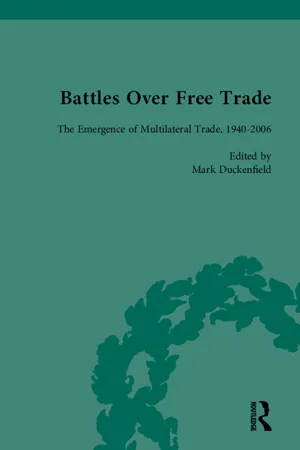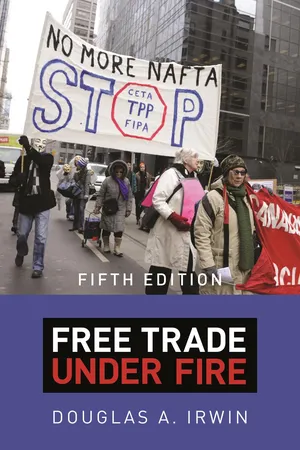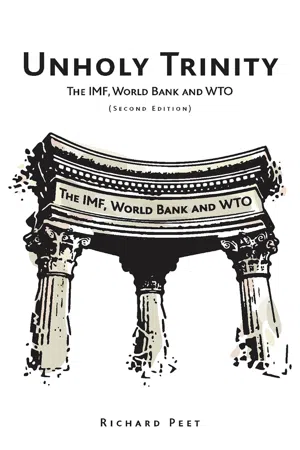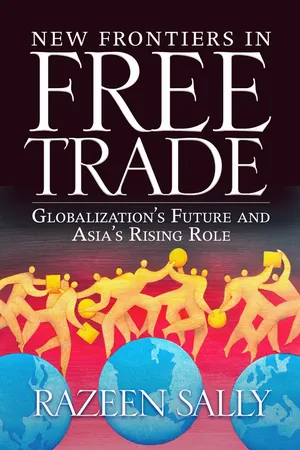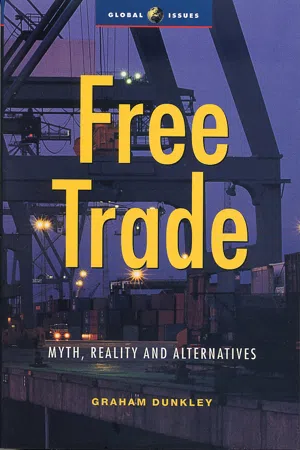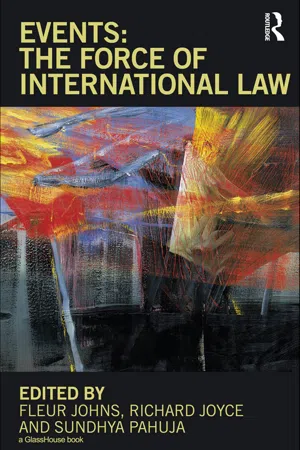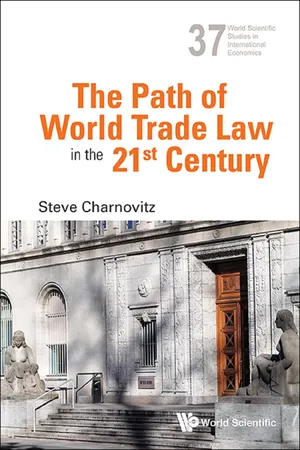Economics
World Trade Organisation
The World Trade Organization (WTO) is an international organization that regulates and facilitates trade between nations. It provides a forum for negotiating trade agreements, resolves trade disputes, and sets rules for international trade. The WTO aims to promote free and fair trade, reduce trade barriers, and support economic development.
Written by Perlego with AI-assistance
Related key terms
Related key terms
1 of 4
Related key terms
1 of 3
10 Key excerpts on "World Trade Organisation"
- eBook - ePub
The Impact of WTO Membership
A Comparative Analysis of China, Russia, and Ukraine
- Anastasia Loginova, Irina Mikheeva(Authors)
- 2017(Publication Date)
- Routledge(Publisher)
The World Trade Organization constitutes an organizational and legal foundation for the international trade system. WTO members account for about 95 percent of the world trade turnover. The WTO determines the rules of international trade in goods, services, and intellectual property, as well as exercises control of their fulfillment. In addition, it is on the WTO basis that principles of common trade relations’ and development directions between the countries are elaborated during collective discussions. The WTO determines the most significant contractual obligations, which act as guidelines for the WTO member states’ governments in lawmaking and law enforcement in the area of trade.The WTO ensures a common institutional framework for conducting trade relations among its members in matters related to agreements and associated legal documents.Like any other organization, the WTO carries out its activities on the basis of certain principles, sets goals, and determines the range of tasks. According to the Marrakesh Agreement, which established the WTO on April 15, 1994, the purpose of the organization is improving the standard of living, ensuring full employment, steady growth of the population’s income, and effective demand for goods and services.12It should be noted that, contrary to the popular belief, the WTO’s objective is not to liberalize international trade, but to ensure fair competition in the global market. Fair competition is achieved by adopting common rules of civilized and economically sound behavior in the world market by the WTO members, based on mutual benefit.13The development of trade and its liberalization through the reduction of barriers, thus, are not an end in themselves. The WTO’s objectives are defined by 1) expansion of production; 2) trade in goods and services with the most efficient use of the world’s resources in accordance with sustainable development objectives; 3) the pursuit of environmental protection; and 4) advanced opportunities, in accordance with the needs and concerns at different levels of economic development. - eBook - ePub
The Politics of International Organizations
Views from insiders
- Patrick Weller, Xu Yi-chong(Authors)
- 2015(Publication Date)
- Routledge(Publisher)
1 The World Trade Organization as an institution Stuart Harbinson• Status of the WTO• Membership of the WTO• Structure of the WTO• Structure of the WTO Secretariat• Secretariat staff• Selection of the Director-General• Organizational issues raised by expanding WTO membership• Appellate Body and secretariat• History and culture: from GATT to WTO• The WTO from 1995 to 2013• Interaction between main groups of players• Decision making• What fears/expectations have been raised? Have these materialized?The Marrakesh Agreement Establishing the World Trade Organization (usually referred to as the WTO Agreement) sets out five functions of the World Trade Organization (WTO). These are:• Conclusion: an organization that needs rebalancing?1 to facilitate the implementation, administration and operation, and further the objectives of, the WTO Agreement itself, as well as the other agreements it covers (known as the “covered Agreements”);2 to provide a forum for negotiations among WTO members concerning their multilateral trade relations; 3 to administer the Dispute Settlement Understanding; 4 to administer the Trade Policy Review Mechanism; and5 with a view to achieving greater coherence in global economic policy-making, to cooperate as appropriate with the International Monetary Fund (IMF) and World Bank.1The WTO came into existence on 1 January 1995. In the years since, it has also expanded into the field of trade-related technical assistance. This has been principally directed, through the means of a trust fund, at building developing countries’ capacity to handle multilateral trade relations.Based on the above, former WTO Director-General Pascal Lamy referred to the WTO as having four basic functions: trade negotiations; implementation and monitoring; dispute settlement; and building trade capacity.The Preamble of the WTO Agreement - eBook - ePub
Battles Over Free Trade, Volume 4
Anglo-American Experiences with International Trade, 1776-2010
- Mark Duckenfield(Author)
- 2017(Publication Date)
- Routledge(Publisher)
THE WORLD TRADE ORGANIZATION, 1994The failure of the United States to ratify the International Trade Organization (ITO) after the Second World War meant that for nearly fifty years the world’s international trading system was operating under a temporary, allegedly impermanent, framework. It was not until 1995 that the creation of the World Trade Organization (WTO) marked a significant change from the ‘provisional’ General Agreement on Tariffs and Trade (GATT) arrangements that had been in existence since 1947. Not only did the WTO create an international institution to manage trade negotiations, it also provided the means for the development of international trade law. While still relying upon the support and cooperation of its members to function, the WTO codified many rules and procedures and created a Dispute Settlement Mechanism (DSM) that allowed for rapid decisions and gave the WTO the power to sanction retaliation against members found to be in breach of WTO rules.1 This was a fundamental change from the GATT where countries which lost disputes could not only delay decisions, but could veto any sanctions against themselves, effectively stripping the GATT of any effective enforcement power.2In the 1980s, a major breakthrough in international trade appeared unlikely. The international trade agenda appeared to have stalled. Europe had embarked upon the Single Market, but it was seen as a step towards the creation of a protectionist ‘Fortress Europe’, rather than as a supporter of freer international trade.3 Protectionist sentiments were also on the rise in the United States Congress as competition from East Asia, especially Japan, threatened the profitability of venerable American textile, steel and automobile companies. The corresponding job losses undermined the American labour movement’s support for free trade and weakened the Democratic Party’s traditional position of support for an open international trading regime. A series of legislative acts in the United States strengthened the unilateral component of American trade policy and enabled the United States to sanction countries it deemed to be using ‘unfair’ trading practices. In a related vein, the Reagan and Bush administrations’ negotiations with Canada and later Mexico signalled a break from the long-standing American commitment to multilateral institutions in favour of bilateral and regional negotiations.4 - eBook - ePub
Free Trade under Fire
Fifth Edition
- Douglas A. Irwin(Author)
- 2020(Publication Date)
- Princeton University Press(Publisher)
7The World Trading System
THE WTO, TRADE DISPUTES, AND REGIONAL AGREEMENTSFor more than seventy years, the General Agreement on Tariffs and Trade (GATT) has provided a system of rules under which international trade has flourished. In 1995, the World Trade Organization (WTO) was established as a formal multilateral institution with new agreements in such areas as services, investment, and intellectual property, along with stronger procedures for resolving disputes. Yet, in recent years, the WTO seems in disarray and trade conflicts seem to have increased, most notably the U.S.–China trade war. This chapter examines the WTO as an institution, its dispute settlement decisions, and the U.S. complaints about both as well as with China. Because the WTO membership has also had difficulty in reaching new agreements, regional trade agreements have proliferated in recent years. This chapter will assess the pros and cons of these regional agreements.The Origins of the GATT System
The motivation to establish a formal system of world trade rules came from the terrible experience of the Great Depression in the 1930s. The Depression was a worldwide economic disaster. Between 1929 and 1932, the volume of world trade fell 26 percent, world industrial production fell 32 percent, and unemployment in many countries topped 20 percent. As the slump intensified, countries responded by raising tariffs and imposing import quotas in a desperate attempt to insulate themselves from the worldwide economic collapse and boost domestic employment. Widespread protectionism—in the form of tariffs, quotas, foreign exchange restrictions, and the like—materialized overnight. These “beggar thy neighbor” policies sought to bolster a country’s own economy at the expense of its trading partners by switching spending from foreign goods to domestic goods. Yet reducing imports proved to be a futile way of combating the economic downturn, because one country’s imports were another country’s exports. The combined effect of this global turn toward protectionism was a collapse of every country’s exports, which merely exacerbated the world’s economic problems.1 - eBook - ePub
Unholy Trinity
The IMF, World Bank and WTO
- Richard Peet(Author)
- 2009(Publication Date)
- Zed Books(Publisher)
We must first deal with the WTO as an institution regulating the conditions of trade. The WTO presents itself as a neutral place where governments can make agreements about trade and resolve the disputes that inevitably arise in an equitable way. The WTO conveys the impression that member governments, meeting in the various councils and committees that convene under WTO auspices, make the basic decisions, and the organization merely carries them out. Yet as the ten benefits cited by the WTO, and listed above, clearly show, the organization does not adopt a neutral stance on trade policy. It is passionately against protectionism and just as profoundly for trade liberalization. The WTO says that it merely provides the forum within which countries decide how low barriers should fall and that it adjudicates the rules written into agreements on how liberalization takes place – that barriers be lowered gradually so that domestic producers can adjust, for instance, or that special provisions for developing countries be taken into account. Here, the WTO says, its objective is ‘fair trade,’ as in non-discrimination, or ensuring that conditions for trade are stable, predictable and transparent. In other words, the WTO’s interpretation of ‘fairness’ is limited to the exact conditions under which free trade occurs – that countries follow the rules, act in transparent ways, and so on. With this narrow restriction, trade can operate ‘fairly’ under a system that more generally favors some interests while harming another.Take, for example, the benefits and costs of trade. When it comes to evidence proving the growth and income benefits of the 1994 Uruguay Round, for instance, the WTO is satisfied with investigative methods that yield estimates of ‘between $109 billion and $510 billion’ added to world income, depending on the assumptions behind the calculations (see point 6 above). In other words, the WTO is willing to take dubious evidence (the higher figure being five times the lower!) as proof of the validity of a position on free trade’s beneficial effects on growth and income. But when it comes to free trade’s effects on workers and unemployment (point 7 - eBook - ePub
New Frontiers in Free Trade
Globalization's Future and Asia's Rising Role
- Razeen Sally(Author)
- 2008(Publication Date)
- Cato Institute(Publisher)
4. The World Trade Organization
The great political virtue of multilateralism, far exceeding in importance its economic virtues, is that it makes it economically possible for most countries, even if small, poor and weak, to live in freedom and with chances of prosperity without having to come to special terms with some Great Power.—Jacob Viner In recent years, the impression has often been given of a vehicle with a proliferation of backseat drivers, each seeking a different destination, with no map and no intention of asking the way. —The Sutherland ReportThe quotes above signify the highs and lows of the World Trade Organization. Its establishment in 1995 was hailed as a significant strengthening of multilateral trade rules. This was supposed to transform a ‘‘power-based’’ trading system into a ‘‘rules-based’’ one, protecting the small and vulnerable from the predation of the big and powerful. It gave flesh, blood, and, above all, legal expression to the founding spirit of the General Agreement on Tariffs and Trade that Jacob Viner wrote about a half century earlier. Prevailing winds outside Geneva were also blowing favorably: liberalization was in the air almost everywhere, in the Organisation for Economic Cooperation and Development, the developing world, and in the ex–command economies.A little more than a decade later, the Doha round seems to be perpetually stalemated and on the verge of collapse. It listed heavily from the start, and several attempts to right it have failed. As the Sutherland Report indicates, the WTO seems immovable: it is full of cacophonous navigators without a compass, steering wildly in all sorts of vague and contradictory directions. Outside Geneva, the winds of liberalization have subsided, there are countercurrents buffeting market-based reforms, and governments seem keener to negotiate a hotchpotch of preferential trade agreements (PTAs) than to do serious business in the WTO. - eBook - ePub
Free Trade
Myth, Reality and Alternatives
- Graham Dunkley(Author)
- 2013(Publication Date)
- Zed Books(Publisher)
The WTO usually states its goals as promoting fair trade, economic growth, ‘sustainable development’ and ‘a system of rules dedicated to open, fair and undistorted competition’ (WTO, 2001: 7). No key WTO document calls for total free trade, and its present rules allow some protection, safeguards, waivers, exceptions and various liberalisation exemptions or extensions for Third World members. However, many WTO officials and supporters want eventual full free trade in goods and services. The WTO (2001) describes itself as embracing five working principles: non-discrimination, transparency, fair trade, ‘special and differential’ (S&D) treatment for Third World members and progressive trade liberalisation. Some brief comment on these principles is in order.There are two forms of non-discrimination: between WTO members (Most Favoured Nation or MFN) and between domestic and foreign traders (National Treatment). MFN simply assures equal concessions to all members, but National Treatment, which says that foreign firms seeking trade must be treated the same as locals, is questionable because it assumes the virtues of globalisation and ignores the Gandhian principle of ‘priority to locals’ (see Chapter 8 ).Box 8.1 The WTO in briefBased on the original General Agreement on Tariffs and Trade (GATT) of 1947, the 145-member (as of early 2003) WTO was formed in 1995 by the historic 1986–93 Uruguay Round of trade negotiations (signed in 1994), replacing the makeshift GATT Secretariat, although the original GATT agreement still applies.The WTO’s operating basis is a three-legged structure of agreements: GATT (updated to 1994) for goods, the General Agreement on Trade in Services (GATS) for services trade, and the Trade-Related Aspects of Intellectual Property Rights (TRIPs) Agreement for ‘knowledge trade’. Under the ‘single undertaking’ rule WTO members must accept these three plus most other WTO agreements. - Marc Froese(Author)
- 2018(Publication Date)
- Routledge(Publisher)
Even so, the Uruguay Round began without a firm idea to create a new trade organization despite the clear need for such an institution. By the end of the round, the so-called World Trade Organization was a full-blooded regulatory institution for global trade. It included a new focus on agriculture liberalization, safeguarding of reforms, new accession procedures, a new dispute settlement mechanism, a well-defined single undertaking for prospective members, new disciplines in intellectual property and services, and an increased awareness of participation for developing countries. 36 Davey explains that the key new elements introduced in WTO dispute settlement were compulsory and exclusive jurisdiction on WTO-related disputes among members, automatic processes that cannot be blocked by respondents, tight timelines for each stage of the process, and an appellate body. 37 Debra Steger, the Canadian jurist tasked with setting up an appellate court, contends that Uruguay Round negotiators did not really intend to make a court because there is only one small provision—Article 17—in the Dispute Settlement Understanding (DSU) on appeals. They were, however, concerned that there might be “the occasional case in which a panel might render a ‘bad report.’” 38 The Appellate Body was a quid pro quo to compensate losing the political right to block the adoption of panel reports. Most panel reports were appealed. By 2001 there were at least 12 appeals per year. 39 In the 20 years since the establishment of the WTO the pattern of shifting equilibria is stronger than ever, with biennial ministerial conferences driving forward a liberalization and institutional development agenda, even as an overall negotiated package remains elusive. The WTO’s main purpose is to secure the gains from trade for members while allowing them to maintain sovereign control over domestic regulatory and market institutions- eBook - ePub
- Fleur Johns, Richard Joyce, Sundhya Pahuja(Authors)
- 2010(Publication Date)
- Routledge-Cavendish(Publisher)
The emergence of the World Trade Organization Another triumph of corporate capitalism? Fiona MacmillanIntroduction
This chapter considers the establishment of the World Trade Organization (WTO) in the context of the rise of corporate capitalism and the structural effects of that ascent on the regulatory structure and institutional environment of the international trade regime. The chapter argues that the rise of corporate capitalism can be traced to at least the establishment of the English East India Company in 1600 and its Dutch counterpart, the Verenigde Oost-Indische Compagnie (VOC), in 1602. Thereafter it followed a trajectory that linked it irrevocably with the international regulatory strategies of the state that represented, as Arrighi (Arrighi 2002) has argued, the ‘dominant agency of capitalist accumulation’ in the relevant period. Focusing on the current period in which the United States has been the dominant state agency, the chapter traces the significance of the relationship between state strategy and corporate capitalism through to the Uruguay Round of trade negotiations and the emergence of the WTO as an intergovernmental institution.The doctrine of comparative advantage
Arguing that there is a fundamental connection between the establishment of the WTO and the growth of corporate capitalism may seem to be what is popularly called ‘a no-brainer’. Yet there is also a contradiction in this position, the acknowledgement of which provides a good taster for the rather muddy waters in which this chapter takes a short dip. The contradiction in question arises as a result of the fact that the commitment to a global free trade regime, which underlies the rhetoric – if not the reality – of the WTO system, is said to be based upon the doctrine of comparative advantage. This doctrine was developed in the work of nineteenth-century classical economists (for example, Ricardo 1817), building on the work of Adam Smith (Smith 1776). - eBook - ePub
- Steve Charnovitz(Author)
- 2014(Publication Date)
- WSPC(Publisher)
This section applies the Montesquieu and post-Montesquieu frameworks to the WTO. It starts with an introduction to the WTO and then discusses in turn each of the three branches of the WTO’s tripartite legal structure. Next there is a discussion of the relationship between the WTO and its member governments and of the relationship between the WTO and social and economic actors. Acknowledging these relationships renders Montesquieu more pertinent to international organizations.The WTO is a society of member governments. Its constitution is the Marrakesh Agreement establishing the WTO (“WTO Agreement”) (Steger 2004, p. 25). The WTO Agreement and the WTO Dispute Settlement Understanding (DSU) contain the structural provisions on institutional competence and the distribution of power. All three sorts of governmental power — legislative, judicial and executive — are found in the WTO Agreement. The legislative power is conferred on the Ministerial Conference and the General Council. The judicial power is conferred on the Dispute Settlement Body (DSB) and the WTO Appellate Body, panels, and arbitrators. The executive power is conferred on the WTO’s D-G and Secretariat. Each of these three powers will be discussed below.The Legislative Power in the WTO
The main legislative business of the WTO is negotiating trade liberalization and writing new rules, and so it is unfortunate that the Doha Round, which has been going on since November 2001, is tied up in knots. Concluding the Doha Round has been strongly supported by the WTO Executive, particularly D-G Pascal Lamy,6 but resistance has come from many member governments — particularly the United States, which has been rudderless in trade policy under the Obama Administration (Yerkey 2009, p. A-2).Ironically, the greatest single legislative achievement of the WTO has been an amendment to the most controversial of WTO agreements, the Agreement on Trade-Related Aspects of Intellectual Property Rights (TRIPS). The TRIPS Protocol makes provision for a system of compulsory licensing of pharmaceuticals for the benefit of other countries. This amendment would not have been enacted but for the extraordinary and influential bottom-up campaign carried out by NGOs, particularly health NGOs (see
Index pages curate the most relevant extracts from our library of academic textbooks. They’ve been created using an in-house natural language model (NLM), each adding context and meaning to key research topics.
Explore more topic indexes
Explore more topic indexes
1 of 6
Explore more topic indexes
1 of 4


